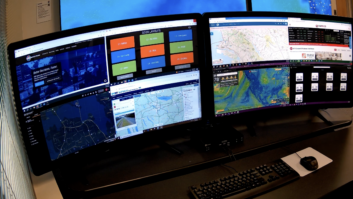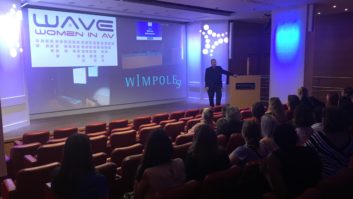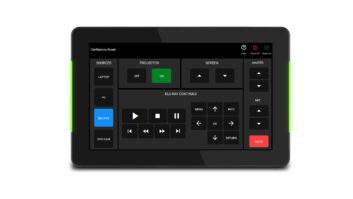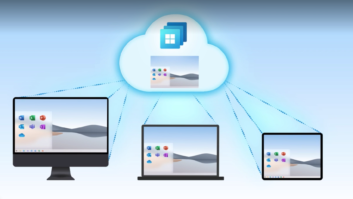AV over IP, unified communications and no-touch interfaces have all become key trends in commercial control, according to major players in the sector.
This direction of travel won’t surprise, but there’s no doubt that Covid has accelerated developments. Ever agile, Pro AV has been quick to respond to the changing landscape, and the implications are profound.
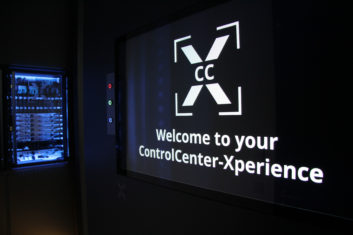 If you’re looking for new trends in commercial control, look to smart integration, Stijn Ooms, director product strategy AV and digital workplace at Crestron tell us. “Complete ecosystems that natively integrate all technology, creating a seamless experience from the moment you enter the workplace…”
If you’re looking for new trends in commercial control, look to smart integration, Stijn Ooms, director product strategy AV and digital workplace at Crestron tell us. “Complete ecosystems that natively integrate all technology, creating a seamless experience from the moment you enter the workplace…”
A practical consequence of the pandemic is the need for solutions that offer a combination of low and no touch control, he says. Users now demand room control (including AV, HVAC and lighting) from their own device; scheduling panels that show meeting room availability without the need to open a door; people counting and motion sensors, and video in every room.
“The pandemic has sped up the digital transformation that was ongoing. Activity based working, for instance, was already a trend but is now exponentially growing in popularity. More and more companies are treating their workplaces as a gathering space for meetings and collaboration; and home offices as a place where employees can work individually, handle calls and mail.”
“Covid has forced companies to adapt extremely fast,” agrees Martina Bersch, PR and marketing for KVM specialist G&D. “We’ve had to introduce innovative ways of working and alternative ways of communicating and interacting with customers. We’ve also had to find new ways of providing our customers with remote presentations and demonstrations. A time where all trade shows are cancelled and customer visits are not possible calls for new solutions.”
Remote demos
One such, says Bersch, was for G&D’s ControlCenter-Xperience (CCX), a remote demo centre.
“Here, we have the chance to present our systems to our customers, provide them with individual consulting or carry our training sessions, either remotely or, once the pandemic is over, live on site.”
“As every sector of our economy has shifted to a remote mode, integrators have also had to shift their capabilities to support,” says Sean Wargo, senior director of market intelligence for AVIXA.
“Instead of designing and building solutions to support in-person experiences, they have instead been supporting the build-out of back-end systems to support remote.”
The obvious example of this is conferencing and collaboration, says Wargo where software and cloud services now facilitate working from home with hardware in the form of cameras, microphones, and headsets.
“This differs from the past in which larger conference rooms in corporate headquarters were the norm.”
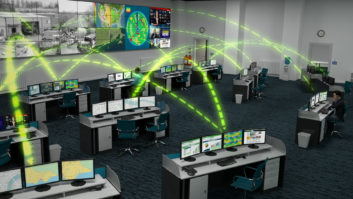 Learning systems and content distribution systems have also evolved, he says. “Virtual live events are trying to engage remote audiences, forcing a shift for events production companies.”
Learning systems and content distribution systems have also evolved, he says. “Virtual live events are trying to engage remote audiences, forcing a shift for events production companies.”
Wargo says the key facilitating technology is AV over IP. “While not new, we have reached a major inflection point in the importance and reliance on AVoIP systems. This has pushed AV and IT into a deeper overlap, with AV professionals now required to have embedded skillsets relating to IP networking while IT professionals learn more about the AV endpoints and content requirements. This is the fundamental nature of project work during the pandemic, likely with legs into the post-pandemic period as many remote behaviours persist.”
Online training
SDVoE (Software Defined Video over Ethernet), a consortium of pro AV manufacturers, system designers and integrators collaborating on the standardised adoption of AVoIP, migrated its entire training platform online just as the pandemic took hold.
SVoDE President Justin Kennington says the group began 2020 with the goal of bringing its already successful and totally online SDVoE Academy, a free AV and IT learning platform, into the real world, through an extended series of live events.
“Well, so much for that! So we shifted our strategy to ‘live events, online’ and the results of that are SDVoE LIVE! our industry’s only bi-weekly edutainment program. We call it ‘TV for pro AV.’ It runs every other Tuesday at 1pm New York time.”
Other challenges, like remote working, swiftly followed, bringing solutions that will have long term implications for pro AV.
“Being a software-defined platform, SDVoE has allowed manufacturers and programmers to quickly adapt to Covid-mandated remote working,” says Kennington.
“Since SDVoE is such a flexible and easy-to-program software-defined network, it’s easy to adapt the traditional functionality of classrooms, conference rooms, presentation spaces, and more to a hybrid environment, where live and remote participants can share content and visual information.”
Modest control
A leader in AVoIP solutions for control rooms is Datapath. Its Aetria platform is just as suitable for modest control rooms as it is for large, multi-source and multi-site organisations.
“With it you can design, manage, control and monitor entire systems from a single interface,” explains John Storey, R&D director. “The ability to securely share anything, anywhere is the objective here – to different workstations, offices, or even buildings. Aetria provides a central interface for all configuration and control, which brings numerous benefits to efficiency, reliability, and the ability for full and fluid collaboration.”
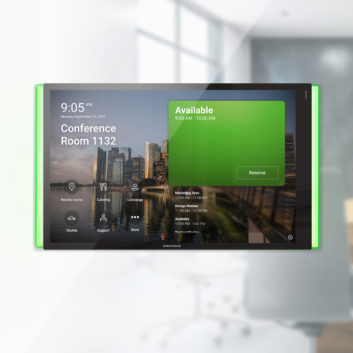 Storey and his team developed a technology that allows optimum quality video to be shared over 1Gb and 10Gb networks simultaneously, with no visual impact on latency and image quality. A 4k video source can be viewed and shared, as both 4k and HD, on a 10Gb network, while also being transferred more widely on a lesser 1Gb network. “We have managed that with imperceptible impact on latency, and zero impact on video quality”, he says.
Storey and his team developed a technology that allows optimum quality video to be shared over 1Gb and 10Gb networks simultaneously, with no visual impact on latency and image quality. A 4k video source can be viewed and shared, as both 4k and HD, on a 10Gb network, while also being transferred more widely on a lesser 1Gb network. “We have managed that with imperceptible impact on latency, and zero impact on video quality”, he says.
Martina Bersch also reports a strong trend towards IP-based systems. “We consider aspects such as advancing networking and centralisation of AV applications and high-end collaborative systems combined with the trend towards more and more IP-based systems to be the driving force of the industry,” she told us, adding that AV installations are constantly expanding and becoming more connected.
“Harmonising and centralising AV applications and improving collaboration within teams have always been important topics, but the current pandemic has made them even more relevant. KVM systems enable the centralisation of applications, while operation is decentralised. They allow you to separate computers from users.”
Bersch notes that with the uptake of remote working, there’s increasing demand for KVM solutions to remotely access virtual machines in the cloud, as well as access systems in-house.
“The pandemic shows us how important remote access to in-house systems is. The obvious question now is how do team members remotely access a KVM system and the underlying on-site computing landscape from home? G&D‘s solution for this issue is called RemoteAccess-GATE. This stand-alone device links the KVM system to the network world, providing remote access to the IT infrastructure connected to the KVM system via LAN, WAN and the Internet. G&D’s RemoteAccess-GATE supports working remotely from home offices and improves the collaboration within teams.”
Hot topic
According to Bersch, such hybrid infrastructures have become a hot topic, where the physical infrastructure on site is supplemented by virtual machines which can be accessed remotely via network protocols.
“How do you standardise the use of hybrid systems in a way that operators can handle them easily, efficiently, and according to their needs? G&D’s RemoteAccess-CPU lets you seamlessly integrate virtual machines from the cloud into KVM matrix installations. Through this, users get a convenient solution that is easy to operate.”
Crestron’s Stijn Ooms says the pandemic, and the changing demographic of industry professionals, has led to the rise of unified communication technologies.
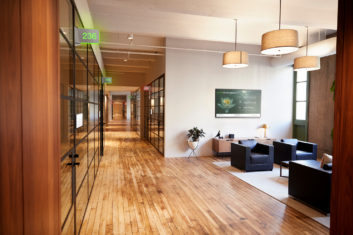 Millennials now make up more than half of the workforce, 75 per cent by 2025, and that’s changing expectations of what an employer and workplace should offer, he comments. It’s forcing companies to rethink the way they use technology. Today, AV teams are more often a part of the IT department.
Millennials now make up more than half of the workforce, 75 per cent by 2025, and that’s changing expectations of what an employer and workplace should offer, he comments. It’s forcing companies to rethink the way they use technology. Today, AV teams are more often a part of the IT department.
“Previously, AV and IT both had a completely different focus: AV wanted to make the most out of any technology, while IT focussed on scalability and usability. The intertwining of both means that companies are increasingly looking for technology that is flexible, scalable, and easy to use and deploy, while at the same time offering a plenitude of possibilities in the backend.
“In a time where adoption rates of new technology skyrocket and where physical distancing is essential, remotely provisioning, monitoring, and managing devices across an enterprise or an entire client base, is a must have.”
Complete systems
The Crestron XiO Cloud is a cloud based IoT platform, allowing IT to remotely access the specific room system from anywhere in the world. It makes it possible to configure complete systems without the need to go on site.
“XiO Cloud also allows us to fix issues remotely,” says Ooms. “For example, in a classroom, a university deploys a new piece of technology for Zoom meetings. If a professor has an issue joining that Zoom meeting to start the class, IT can remotely access his system through XiO Cloud. They can see the system that the professor is working with and can control the system remotely.”
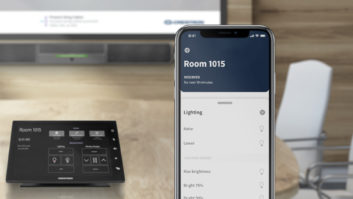 XiO Cloud can also gather data needed for space optimisation. “Instead of just knowing that a room is booked, companies want to know if it was actually used, by how many people and what technology”, Ooms goes on. “Releasing AI on the collected data allows companies to make a correct decision when deciding on real estate, instead of simply following their gut.
XiO Cloud can also gather data needed for space optimisation. “Instead of just knowing that a room is booked, companies want to know if it was actually used, by how many people and what technology”, Ooms goes on. “Releasing AI on the collected data allows companies to make a correct decision when deciding on real estate, instead of simply following their gut.
“For instance, projects that combine low touch and no touch control (like Crestron ONE) with scheduling panels that show meeting room availability without the need to open the door, people counting and motion sensors, and video in every room.”
Ooms also cites home working solutions, like the Crestron Home Tabletop Conferencing Device and the newly launched Crestron Personal Communication Device, which improves the comfort of a workforce at home.
As for the future, Ooms points to complete, smart integration.
“Just imagine planning a meeting with someone. Your invitation includes a question on the license plate and on food allergies. So, when your visitor arrives, the camera immediately recognises his license plate and the gates open. Signal displays guide him to his automatically reserved parking space. At the same time, you receive a message that your visitor arrived so you can meet him in the scheduled room. He gets out of the car and follows the displayed directions to the meeting room, where his, allergens free, lunch will be served at the time you requested. The lights in the meeting room will reflect the weather outside, and the air quality is constantly monitored and adjusted. When the meeting room display is turned on, the blinds automatically lower.”
Ooms is convinced that this type of UC solution will empower a safe return to the office. He could well be right.


